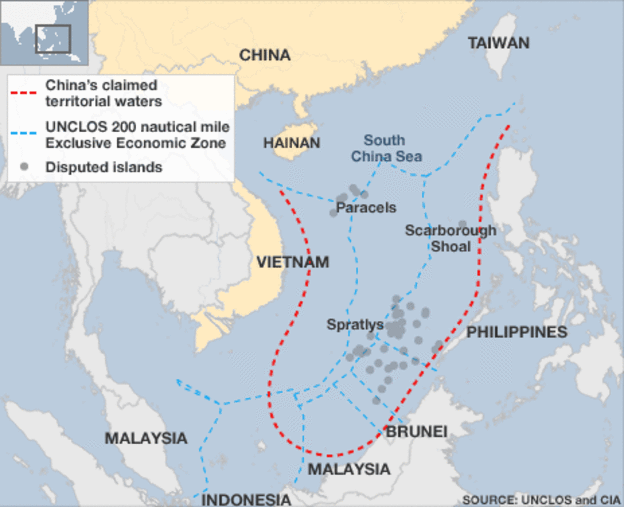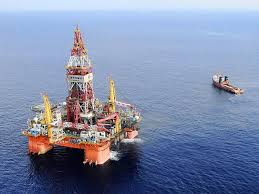www.aljazeerah.info
News, June 2015
Archives
Mission & Name
Conflict Terminology
Editorials
Gaza Holocaust
Gulf War
Isdood
Islam
News
News Photos
Opinion Editorials
US Foreign Policy (Dr. El-Najjar's Articles)
www.aljazeerah.info
|
Editorial Note: The following news reports are summaries from original sources. They may also include corrections of Arabic names and political terminology. Comments are in parentheses. |
China Moves Controversial Oil Rig Back Towards Vietnam Coast
June 26, 2015
 |
 |
| Map of disputed area in South China Sea | Chinese oil rig in South China Sea |
https://en.wikipedia.org/wiki/Haiyang_Shiyou_981_standoff
China moves controversial oil rig back towards Vietnam coast
Fri Jun 26, 2015 5:16am EDT
BEIJING, Reuters --
China has moved an oil rig at the center of last year's violent dispute with Vietnam closer to Vietnam's coast in the disputed South China Sea, just weeks ahead of the first visit by a chief of Vietnam's Communist Party to Washington.
The move, announced by China's maritime safety authorities, comes soon after the country indicated it was close to setting up new outposts in the maritime heart of Southeast Asia, as it nears completion of land reclamation in the South China Sea.
China claims most of the potentially energy-rich South China Sea, through which $5 trillion in ship-borne trade passes every year. The Philippines, Vietnam, Malaysia, Brunei and Taiwan also have overlapping claims.
China's deployment of the rig last year in what Vietnam called its exclusive economic zone and on its continental shelf, about 120 nautical miles off its coast, led to the worst breakdown in relations since a brief border war in 1979.
Vietnam's people remain embittered over a perceived history of Chinese bullying and territorial claims in the South China Sea, although China said at the time the rig was operating completely within its waters.
The rig now appears to be in an area where the exclusive economic zones (EEZ) of Vietnam and China overlap, but further away than last year, said Le Hong Hiep, a visiting fellow at Singapore's Institute of South East Asian Studies.
In an online statement posted on Thursday, China's Maritime Safety Administration said the 'Haiyang Shiyou 981' rig would carry out "ocean drilling operations" 75 nautical miles south of the resort city of Sanya on southern Hainan island.
Experts estimate the drilling site is about 104 miles (167 km) east of the Vietnam coast. The $1-billion rig will remain there from June 25 until August 20, the statement said, telling ships to stay 2,000 m (6,562 ft) away for safety reasons.
Vietnam's maritime authorities were monitoring the rig's placement, the website of the country's state-controlled Tuoi Tre newspaper on Friday quoted unidentified sources as saying.
The rig movement comes weeks before Vietnam's top leader, Nguyen Phu Trong, is expected to visit the United States, in the first such trip by a general secretary of the nation's Communist Party.
His mission is expected to further boost warming strategic ties between Washington and Hanoi - a relationship eyed warily in Beijing.
It also comes amid rising concerns at China's rapid creation of artificial islands on South China Sea reefs - construction criticized by the U.S. and protested by Vietnam.
However, Le Hong Hiep, the Singapore-based analyst, said he felt Hanoi would not protest as strongly as it did last year if China said the rig was placed within an EEZ claimed from Hainan Island rather than one from the hotly disputed Paracel Islands, as it did last year.
Vietnam and China agreed on an equal split of the maritime boundary of the Gulf of Tonkin in 2000 but have yet to agree on demarcating waters further south, near the rig's current site.
Earlier this year, the rig was drilling in the Andaman Sea off the coast of Myanmar, tackling the deepest exploration well it has so far undertaken, its owner, state energy group China National Offshore Oil Corporation (CNOOC), said in an earlier statement.
CNOOC could not immediately be reached for comment on Friday.
(Reporting by Ben Blanchard and Adam Rose in Beijing; Greg Torode in Hong Kong; Editing by James Pomfret and Clarence Fernandez)
Background:
China Unveils Major South China Sea Gas Find
Large yields may further fuel resource extraction efforts in contentious waters.
By Prashanth Parameswaran for The Diplomat February 11, 2015 Facebook580 Twitter115 Google+13 LinkedIn10 718 Shares 86 Comments
China said Saturday that a recent gas discovery in the contentious South China Sea could yield more than 100 billion cubic meters of natural gas, highlighting Beijing’s continued efforts to extract resources from waters in spite of lingering territorial disputes with neighboring countries.
On February 7, Global Times reported that China National Offshore Oil Corp (CNOOC) had disclosed that the Lingshui 17-2 gas field, discovered 150 kilometers south of China’s southernmost island of Hainan, had an annual output of up to four billion cubic meters.
Xie Yuhong, a manager with CNOOC, characterized that estimate as “conservative.”
The Lingshui 17-2 gas field made headlines when it was originally discovered in September last year because it was China’s first deepwater gas field discovery in the South China Sea. The field was discovered by China’s first deepwater drilling rig, CNOOC 981, which was completed in 2011.
The 100 billion cubic meter yield is significant even when placed against Beijing’s massive and still growing natural gas needs. According to a recent report by the China Petroleum and Chemistry Industry Federation, China’s natural gas consumption amounted to 180 billion cubic meters last year, while proven reserves reached around 37 trillion cubic meters.
Roughly a third of China’s consumption was imported, however. China has been trying to decrease its reliance on other countries partly by redoubling efforts to develop oil and gas extraction projects in the South China Sea. Lin Boqiang, an energy expert from Xiamen University, told Global Times that although the State Council had urged the country to speed up such efforts in November last year, the lack of deepwater exploration technology has reportedly been a key obstacle.
Despite the fresh hype over the size of the find, analysts have cautioned that it may take a few years for the necessary infrastructure to be put in place in order for the field to actually contribute to domestic gas production.
While calculating energy reserves in the South China Sea very much remains an inexact science, one estimate claims that about a third of China’s current oil and gas reserves are offshore, and a third of those offshore reserves are in the South China Sea, mostly in deepwater.
***
Share this article with your facebook friendsFair Use Notice
This site contains copyrighted material the
use of which has not always been specifically authorized by the copyright
owner. We are making such material available in our efforts to advance
understanding of environmental, political, human rights, economic,
democracy, scientific, and social justice issues, etc. We believe this
constitutes a 'fair use' of any such copyrighted material as provided for
in section 107 of the US Copyright Law. In accordance with Title 17 U.S.C.
Section 107, the material on this site is
distributed without profit to those
who have expressed a prior interest in receiving the included information
for research and educational purposes. For more information go to: http://www.law.cornell.edu/uscode/17/107.shtml.
If you wish to use copyrighted material from this site for purposes of
your own that go beyond 'fair use', you must obtain permission from the
copyright owner.
|
|
|
|
||
|
||||||


